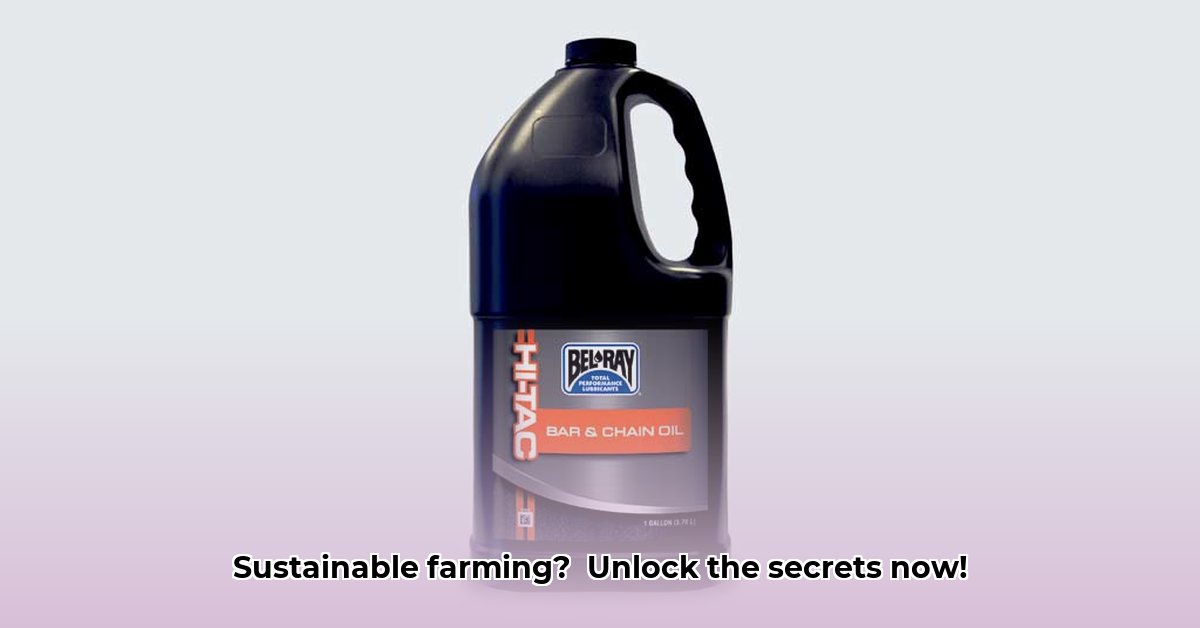
Bar and Chain Oil Tractor Supply: Essential for Sustainable Farming
Maintaining peak farm equipment performance is vital for a successful and sustainable operation. This extends beyond routine fueling; it requires consistent, proactive maintenance, starting with something as seemingly fundamental as using the correct bar and chain oil. Let's explore how diligent maintenance contributes to both a productive farm and eco-friendly practices. For more information on farm equipment maintenance, check out Tractor Supply Returns.
Preventative Maintenance: The Unsung Hero of Sustainable Farming
Think of your farm equipment as a hardworking team. Regular check-ups and preventative maintenance are essential, just as they are for human health. Ignoring minor issues can lead to major, costly breakdowns. Regular lubrication with the appropriate bar and chain oil, for example, significantly extends equipment life, saving money and reducing downtime. This is a straightforward yet incredibly impactful step towards sustainable farming practices.
Oil Selection: A Critical Decision for Optimal Performance
Choosing the correct bar and chain oil transcends simply selecting the cheapest option. Several factors influence oil selection:
- Climate: Extreme temperatures necessitate oils formulated to withstand heat or cold without compromising viscosity.
- Chain Type: Different chains require oils with varying properties designed for their specific functionality. Using an improper oil can cause damage.
- Workload: Heavy use demands a more robust oil formula; lighter tasks might suffice with a less intensive oil.
Always reference your equipment's manual for manufacturer-recommended oil specifications. Using incompatible oil can lead to costly repairs and inefficiencies. Choosing the right oil is a crucial investment in your farm's long-term health.
Beyond the Oil: Comprehensive Sustainable Farming Strategies
Efficient equipment maintenance is merely one element of building sustainable farming practices. Other critical aspects include:
Precision Irrigation: In areas with water scarcity, precision irrigation systems use sensors and technology to deliver water precisely where and when needed. This minimizes waste, conserves resources, and reduces costs while being environmentally responsible. It's about providing crops with exactly the right amount of water, no more, no less. Isn't optimizing water use a crucial step towards a sustainable future?
Soil Health: Healthy soil efficiently retains water, minimizing irrigation needs. Techniques such as cover cropping, no-till farming, and crop rotation enhance soil structure and fertility. Did you know that healthy soil can reduce water consumption by as much as 20%?
Smart Crop Selection: Choosing drought-resistant crops is vital in water-scarce regions. These crops thrive with minimal water, enhancing farm resilience during dry periods.
Integrating Practices for a Sustainable Future
Combining smart equipment maintenance with sustainable farming strategies improves farm productivity while minimizing environmental impact. The initial investment in quality tools and practices is quickly offset by long-term gains: reduced downtime, extended equipment lifespan, and decreased resource consumption. It's about building a resilient, profitable business that is also environmentally responsible. How can we further improve integration between technology and sustainable agriculture?
Precision Irrigation: Optimizing Water Use in Arid Climates
Key Insights:
- Efficient irrigation is crucial due to water scarcity in arid regions.
- Precision irrigation dramatically decreases water waste and improves resource efficiency.
- Different irrigation systems—drip, micro-spray, subsurface—present unique advantages and drawbacks.
- System selection depends on factors like crop type, budget, and soil conditions.
- Success hinges on correct implementation and careful maintenance.
Assessing Your Farm's Needs
Before selecting a precision irrigation system, carefully analyze your farm's specifics. What crops do you cultivate? What's the soil composition? What's your land area? What is your budget for this investment? These factors are essential to choosing the most effective system.
Comparing Precision Irrigation Systems
Several systems offer precise water delivery, each with its own set of benefits and challenges:
Drip Irrigation: Water is directly delivered to plant roots, minimizing evaporation, maximizing efficiency. Potential downsides include clogging and higher initial costs. Drip irrigation can improve water-use efficiency by up to 50% compared to traditional methods.
Micro-spray Irrigation: Similar to drip, but water is sprayed in a fine mist, making it suitable for larger plants. However, its efficiency can be less than drip irrigation and distribution may be uneven.
Subsurface Irrigation: Water is delivered underground, drastically reducing evaporation. Highly efficient, but installation is costly and requires specialist expertise.
Choosing the Right Precision Irrigation System
| System Type | Advantages | Disadvantages | Cost |
|---|---|---|---|
| Drip Irrigation | High water efficiency, reduced weeds, targeted water delivery | Clogging risk, higher initial investment | Medium-High |
| Micro-spray Irrigation | Moderate water efficiency, suitable for larger plants | Higher water use than drip, potential for uneven coverage | Medium |
| Subsurface Irrigation | Maximum water efficiency, minimal evaporation, reduced weed growth | High installation cost, potential leaks, specialist needed | High |
Implementing a Precision Irrigation System: A Step-by-Step Guide
- Needs Assessment: Evaluate crop requirements, soil, water availability, and budget. This dictates system selection.
- System Design: Create a detailed plan including piping, emitter spacing, and water sourcing. Professional help may be beneficial.
- Installation: Follow the manufacturer's instructions carefully. Expert installation is recommended, particularly for subsurface systems.
- Testing and Calibration: Test thoroughly and calibrate to ensure even water distribution and pressure. Make adjustments as necessary.
- Maintenance: Regularly maintain the system (flushing, inspecting emitters) to prevent blockages and ensure high efficiency.
Addressing Barriers to Precision Irrigation Adoption
High initial costs represent a significant hurdle for many farmers. Government subsidies and financing programs can help. Lack of knowledge is another barrier; workshops and training initiatives can address this. Community-based water management can enhance overall water use efficiency. What strategies can help overcome the financial limitations associated with implementing precision irrigation?
[1AgriRevu. (n.d.). Comparing different types of irrigation systems: Pros and cons. Retrieved from https://agrirevu.com/comparing-different-types-of-irrigation-systems-pros-and-cons/]